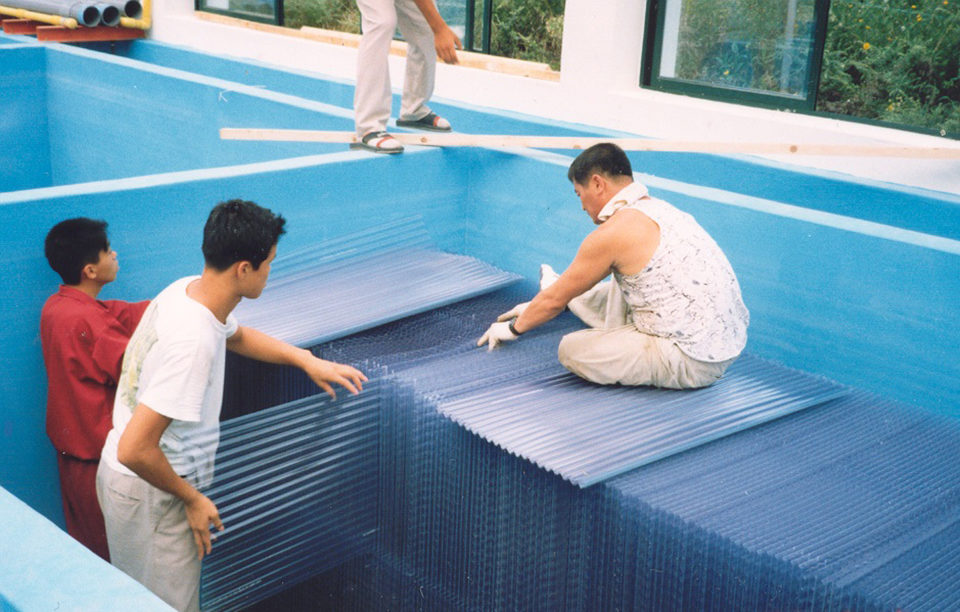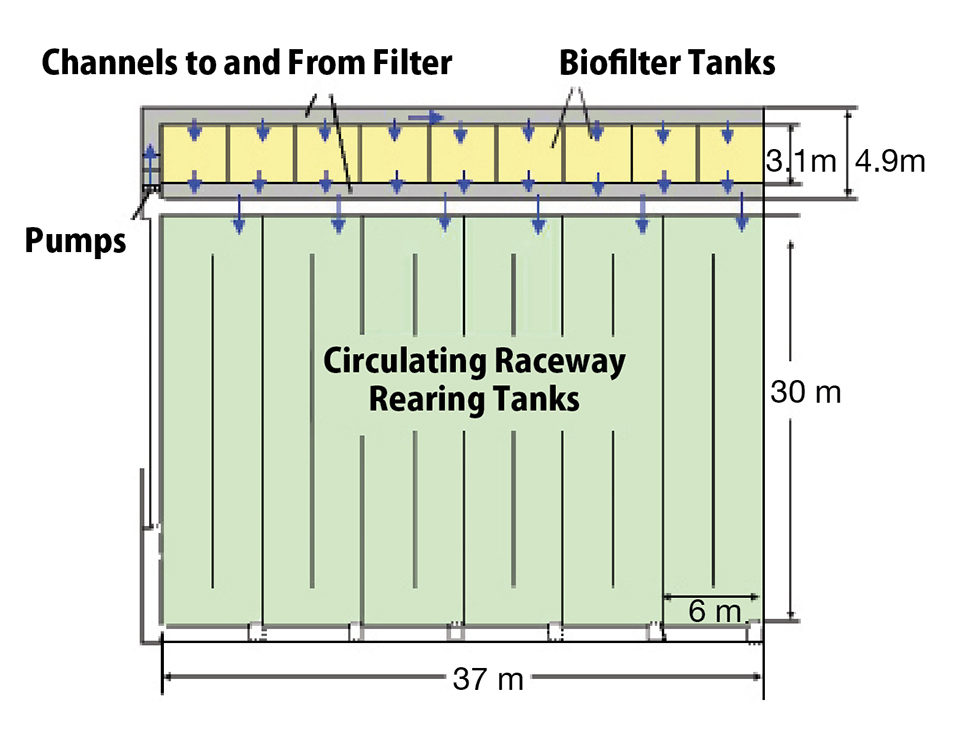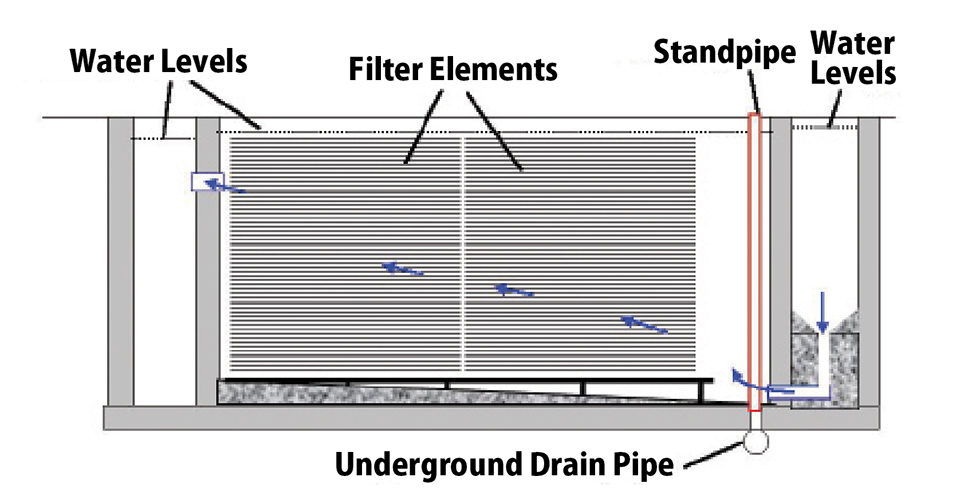Method for RAS maintenance better solution than settling and screen trapping

Reducing solids, especially suspended solids, has been a difficult problem in the water of recirculating aquaculture systems. Neither of the two methods of solid waste removal – settling and screen trapping – solves this problem effectively, especially for fine solids.
In research, the authors found that the biofilter unit portion of the Intensive Bioproduction Korean (IBK) system originally developed for nitrification also has excellent capability to remove suspended solids. The system is easy to maintain and has a low power requirement to treat a large amount of water. With two, 5-hp pumps, about 500 cubic meters of water can be treated hourly.
Flow speed in the filter elements is very low, which in conjunction with the very large surface area onto which suspended solids settle provides effective trapping of fine solids. High-volume treatment is another feature.
System structure
The authors tested the IBK system in a semiclosed trout farm where major solid wastes were removed right from the rearing tanks using a specially designed sedimentation method. Therefore relatively clarified water entered the IBK system biofilter.
The farm had a standing crop capacity of 20 metric tons (MT) and annual production of 70 MT of rainbow trout. The filter, which occupied a larger area than other biofilters (Table 1 and Fig. 1), consisted of nine concrete tanks.
Kim, Filter tank data, Table 1
| Dimension | Value |
|---|---|
| Width of filter tank | 4.0 m |
| Length of filter tank | 3.1 m |
| Net floor space of one filter tank | 12.4 m2 |
| Net floor space of nine filter tanks | 111.6 m2 |
| Total floor space including channels and walls | 183.8m2 |
| Total space of six fish-rearing raceways | 1,126.m2 |
| Total filter area against fish-rearing area | 16.4% |

The net floor space occupied by the biofilter reflected 10 percent of that of the rearing tanks. When the channels for influent to and effluent from the filter were included, the total space for the filter was about 16 percent of the rearing tank area. The open channels substitute for the pipes, fittings and valves required for other types of biofilters.
Biofilter unit
One unit of the filter tank occupied 4 meters x 3.1 m net floor space. The depth of the tanks was 1.7 m at the deepest point and 1.6 m at the shallow end. The section view of this biofilter under operation is depicted in Fig. 2.

The filter elements were corrugated polyvinyl chloride roofing panels, which are readily available and cheaper than specially developed and patented products. The width of the commercial panels was 63 cm, but the length varied. One layer of the assembled filter element consisted of two panels put side by side.
To assemble the panels into filter elements, the length was 127 cm, twice the width to make one square layer. Filter element layers were assembled with one layer vertical and the next horizontal.
Each layer occupied 1 cm x 127 cm floor space. The system required 1,600 panels for each tank for a total of 14,400 panels. The cost of the panels for the nine filter tanks was about $21,600 in Korea in April 2008.
Suspended solids settled onto the grooves of the horizontally oriented panels. Each panel had 20 grooves that provided 40 horizontal surfaces. Because each layer consisted of two panels, one layer had 80 such surfaces. On average, the IBK biofilter offered 40 times more available settling surface than conventional settling tanks, which offer only bottom surface for trapping solids.
Filter performance
To circulate water, three 3.7-kw low-head, axial-flow vertical pumps were installed. Water was circulated by two pumps at about 500 cubic meters per hour or 12,000 cubic meters per day, while the remaining pump was available for emergency purposes. This power savings was achieved by the small 0.5-meter difference in levels between the tops of the filter and rearing tanks.
When water containing solid wastes of varying sizes was treated, 74.5 percent of the total suspended solids was trapped in a single pass through the biofilter. About 40.0 percent of the nonsettleable solids was removed. Here non-settleable solids were designated as the suspended solids that remained suspended after five minutes in a 20-liter bucket.
It took 20 minutes for water particles to pass through the filter bed, requiring three passes for 500 cubic meters per hour. Calculated average flow speed in the filter was 2.6 mm/second (Table 2).
Kim, Flow data in the filter, Table 2
| Value | |
|---|---|
| Total volume of water passing through filter | 500.00 m3/hour |
| Number of filter tanks | Nine |
| Volume of water passing through one tank | 55.56 m3/hour |
| Cross-flow section area of one tank | ca. 6 m2 |
| Flow speed in filter tank | 2.57 mm/second |
| Time required for water to pass filter | 20.1 minutes |
Although nitrification by the biofilter decreased as organic wastes accumulated on the surfaces of the filter media, it was not of great concern at the study fish farm because major solid wastes were removed in the sedimentation tanks right after rearing tanks. Furthermore, settled solids occupied only a quarter of the filter media surfaces, and the remaining surfaces were free from organic wastes.
Perspectives
The IBK system biofilter requires rather extensive floor space, but it seems to be feasible for use in fish farms with recirculating systems if designed in combination with rearing tanks and open water circulation channels. This type of filter could also be applied to treat the effluents of fish farms instead of detention ponds, which require a more extensive area to operate.
(Editor’s Note: This article was originally published in the January/February 2009 print edition of the Global Aquaculture Advocate.)
Now that you've finished reading the article ...
… we hope you’ll consider supporting our mission to document the evolution of the global aquaculture industry and share our vast network of contributors’ expansive knowledge every week.
By becoming a Global Seafood Alliance member, you’re ensuring that all of the pre-competitive work we do through member benefits, resources and events can continue. Individual membership costs just $50 a year. GSA individual and corporate members receive complimentary access to a series of GOAL virtual events beginning in April. Join now.
Not a GSA member? Join us.
Authors
-
In-Bae Kim, Ph.D.
Pukyong National University
c/o Fish Culture Station
Nam-gu, Busan 608-737 Korea[32,109,111,99,46,108,105,97,109,116,111,104,64,109,105,107,101,97,98,110,105]
-
Jae-Yoon Jo, Ph.D.
Pukyong National University
c/o Fish Culture Station
Nam-gu, Busan 608-737 Korea
Tagged With
Related Posts

Health & Welfare
Biofilter inoculation in recirculating aquaculture systems
Biological filters are essential parts of recirculating aquaculture systems that transform toxic fish compounds such as ammonium and nitrite into less-harmful nitrate. The authors tested the convenience and efficiency of three methods for the initial inoculation of aerobic biofilters.

Innovation & Investment
Estimating biofilter size for RAS systems
Controlling total ammonia-nitrogen (TAN) concentrations is the primary concern when sizing a biofilter for use in a recirculating aquaculture system. Sizing decisions are best based on previous experience with a given biofilter media in a specific biofilter configuration.

Responsibility
A look at unit processes in RAS systems
The ability to maintain adequate oxygen levels can be a limiting factor in carrying capacities for RAS. The amount of oxygen required is largely dictated by the feed rate and length of time waste solids remain within the systems.

Responsibility
Advances in super-intensive, zero-exchange shrimp raceways
Research at the Texas AgriLife Research Mariculture Laboratory is investigating ways to improve the economic viability of super-intensive raceways for shrimp production.


